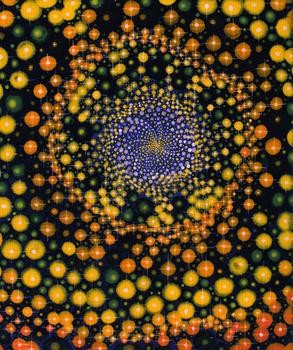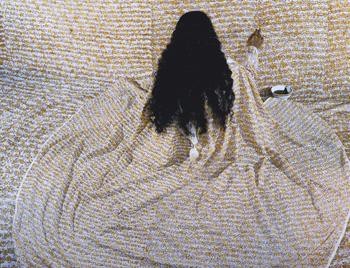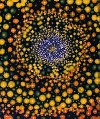DeCordova Annual 2005
Overview of Art in New England
By: Charles Giuliano - Sep 23, 2013
The 2005 DeCordova Annual Exhibition
Including: Jean Blackburn, Lalla A. Essaydi, Milan Klic, Michael Lewy, Sally Moore, Laurie Sloan, Barbara Takenaga, Nao Tomii, Nadya Volicer, Mark Wethli
Curated by: Rachel Rosenfield Lafo, Nick Capasso, George Fifield, Alexandra Novina
The DeCordova Museum and Sculpture Park
Lincoln, Mass.
April 30 through July 31
Catalogue, 24 pages, illustrated, published by the DeCordova
Reposted from Maverick Arts Magazine
Consistent with its mandate the DeCordova Annual Exhibition is intended to draw upon the arts in the entire New England region. But this time, thankfully, we are spared weavers from Vermont, potters from Provincetown, or crafts from RISD. Which is a New England state. If only a state of mind. But the curators do stretch the notion of New England by including in the mix artists who reside here but whose origins and sensibilities are international. Of the ten artists in the exhibition a third are from a combination of the Czech Republic, Morocco, and Japan, a fourth artist, born in the USA, brings an Asian sensibility to the work.
With just ten artists- Jean Blackburn, Lalla A. Essayadi, Milan Klic, Michael Lewy, Sally Moore, Laurie Sloan, Barbara Takenaga, Nao Tomii, Nadya Volicer and Mark Wethli- the exhibition seemed more sparse and reductive than the clutter of past installations. But, curiously, so was the attendance at the vernissage last night. Sparse that is. As the evening progressed I wondered when the usual crowd would show up. It didn’t. A couple of artists who did attend- Gerry Bergstein and Domingo Barreres - commented in frantic haste that they had to leave promptly in order to rush back to town in time to support artists opening on the usual first Friday in the South End. For me, it had been a coin toss as to which event to attend in far flung locations. I opted for the DeCordova but, in hindsight, the South End might have been more fun. Wonder why the folks at the DeCordova didn’t check their calendars and avoid such an obvious conflict. Also, the art crowd has been maxed out with events related to the biannual Cyberarts Festival. Its director, George Fifield, a curator of the DeCordova for new media, was on hand but reported that he had attended a similar event every night for the past two weeks. He appeared energized if a bit fried.
So many thoughts were running through my head as I drove home along Trapelo Road, past the manses of the ruling class, through posh Lincoln. It tried to channel the other Charles. Baudelaire, that is, and his often droll reviews of the Salons of 19th century France. Reading those reviews today is a challenge to anyone not an expert on the tedious academic art of that era. One would The Academy was lost and forgotten until it was dragged up from the basement more than a decade ago in the reinstallation that became the Musee Dorsay as we know it today. There is also the revisionist text by Robert Rosenblum and H. W. Janson “19th Century Art” that insisted on presenting the entire range of art of that era rather than the winners of the contentious conflict between the academy and the avant-garde. Add to that travesty the tedious efforts of feminists to pump new life into such dead ducks as the enervating painter of horses and farm animals, Rosa Bonheur.
How would Baudelaire have approached the task of covering this annual Salon? Of course, the task was always easier when the exhibition included scandalous works by artists that he championed such as Manet and Courbet. That helped to liven his prose and offend the bourgeois taste of the easily shocked French public. He was at his best manning the barricades of the avant-garde. How he must have loved sinking his teeth into “Olympia” or the “Funeral at Ornans.”
But, no such luck here. Nothing even approaching a whiff of scandal. Instead a competently assembled if not exactly inspired overview of the latest tendencies on the art world. The exhibition does indeed have the look of the moment. And any competent critic or artist could easily mention a dozen or more artists who deserved to be included. But, this is their show not mine so I will confine remarks to what is on view.
Don’t get me wrong. I love the idea of an annual Salon. Where would we be without it? This gives hope to one and all. Like winning the lottery there is always the possibility of being included in these surveys. It is the opportunity to make a mark and launch further career efforts. Or, as is more often the case, to slip into oblivion. Like finishing in the back of the pack at the Kentucky Derby. We only remember the winners. But on the day of the running of the roses everyone was a potential winner. Like last night in Lincoln.
For me, the best in show was hands down the zippy, zappy, psychedelic, op paintings by Barbara Takenaga. Psychedelic Art is back in a big way with a major exhibition, all wrong by the way, now on view at Tate Liverpool. I should know because back in the day I organized the first Psychedelic Art exhibition “The Visionaries” for the East Hampton Gallery in New York City in the late 1960s. That exhibition which was extensively covered in the New York media became the basis of the Grove Press book “Psychedic Art” by Masters and Houston. It featured a cover work by Isaac Abrams, the same painting which is now the website logo for the British show. But other than Abrams and Abdul Marti Klarwein (who did covers for Miles Davis’s “Bitches Brew” and albums by Santana) who were included in my show, the rest of the list seems incorrect. The curators are second guessing an era they were not a part of, man.
Yes, by all means, the delicious and dreamy, hypnotic, gorgeous paintings by Takenaga. Trippy man. Lucy in the Sky with Diamonds. Her work is like totally 2005. More so than anyone else in this survey. Hopefully Camilo Alvarez will include her in the much anticipated “Opish” show that he is planning for Samson Projects. I also suggested to him Reese Inman and Masako Kamiya as well as an emerging artist, Lisa Raad, whom I will show at New England School of Art in the Project Space in June. He did follow my suggestion to contact and include Will Mentor but has avoided the rest of my advice. Oh well, I like Camilo but he ain’t yet hip to the jive. Takenaga earned a B.F.A and M.F.A. from the University of Colorado and now teaches at Williams College.
As is the custom for these events gallerist Howard Yezerski was on hand manning the booth that displayed the large format photographs, some virtually life size, by the Moroccan born, Boston based artist, Lalla A. Essaydi. She has enjoyed considerable exposure and success with her work, in painting and photography, since finishing her M.F.A. degree from the School of the Museum of Fine Arts/ Tufts University a couple of years ago.
I met her there and spent time in her cubicle surrounded by stacks of boxes of color prints and some works on the easel.
We talked about the issues of Islamic culture in her work and the influences of such contemporary artists as Sharin Neshat, Mona Hatoum and the racist, sexist tradition of 19th century French Orientalism from Ingres and Delacroix through Jean Leon Gerome. There are significant works by Gerome in the collection of the Clark Art Institute which she has appropriated in her paintings. There is an upcoming exhibition planned for the Williams College Museum of Art that will show Essaydi’s paintings and borrow the works by Gerome that they reference from the Clark which is a neighbor.
These epic scaled photographs are rich and compelling. They feature a series of women and children swathed in robes and veils covered with text in Arabic. It is labor intensive work the deep layers of meaning of which are inaccessible to an American viewer with no knowledge of the language and little understanding of its cultural imperatives. So they exist for the viewer on the seductive level of appearances. They quote and comment on the complex issues of Orientalism, racism, the oppression of women and Colonialism. She brings to the work the passion and pain of an insider. At the DeCordova, Lalla was smartly dressed in the Western manner but when she travels to Saudi Arabia to visit her husband and family she must wear the veil and conform to what is viewed as the oppression of women by Western standards. She probes this from within but there are very real constraints to her freedom of expression. When she has been interviewed in the Boston Globe, for example, she expressed concern that details confided to the reporter were published. Her fear is that such disclosures will have serious repercussions. The element of risk taking in the work is very real and gives to it a critical edge. But it is also a constraint that I feel has prevented a real breakthrough. It sets daunting limits and the artist has responded with images that are arguably too attractive and veiled. While I am familiar with the exterior I have yet to penetrate the soul of this artist. Given the cultural context that is perhaps too much to ask.
When entering the space with an array of slick, biomorphic, silver forms attached in relief to the walls set into puddles of bleeding blue, or viewing the ersatz space plants in pots, it was not necessary to read the wall labels to know that this was the work of a young Japanese artist. Nao Tomii is a graduate of the Montserrat College of Art in Beverly, Mass. and also holds a degree from the Niigata Collage of Art and Design in Niigata, Japan, He shows with Clifford-Smith Gallery in Boston. One sees a fair amount of work like this, but as an emerging artist with limited resources, shown here on a modest scale. But what is consistent is the feeling that the work is manufactured more than created. It has that pop culture, mass produced sensibility. The Japanese have seemingly invented a contemporary version of Art Nouveau and Art Deco. It is not a negative to say that the work is slick and pop. There is a lot of wit and humor here. Fun stuff.
The small, model like creations of Sally Moore have enjoyed critical attention and success when shown at the Barbara Krakow Gallery in Boston including a review in Art Forum. They relate to a broad tendency of highly detailed, well crafted pieces that evoke elements of surrealism and fantasy. Again, one encounters a fair amount of work of this genre of which Moore is a superb example. But lacking a vivid imagination I can’t really say what they are about.
Most of the rest of the show I either didn’t like or approached with indifference. Like the deconstructed chopped up furniture and chewed up rug by Jean Blackburn. Guess I just missed that lecture on Post Modern theory. Sure enough she teaches at RISD so expect to see an emerging generation of this sensibility. Oh well. For me a hole in a chair is a hole in a chair. Again it’s that vision thing. Or lack thereof. Mine not hers. Whatever. Yes, Nadya Volicer, who lives and works in Marion, Mass. worked real hard to cut up all that found painted wood and put it all together as a tube, arch through a hallway on the upper level of the DeCordova. But? Mark Wethli, director of the visual arts program at Bowdoin College painted a series of bright circles of color of varying sized onto the tall narrow wall at the end of the grand staircase. A number of artists have tackled that difficult space. But it didn’t seem to tell me enough about the artist’s work to draw any conclusions. The series of works by Laurie Sloan on either side of a long narrow corridor, something about whimsy on paper, did not hold my attention. Ditto the techie room with work by Michael Lewy. And the flimsy/ delicate contraptions of Milan Klic just annoyed me.
This is where the writer is supposed to think of something clever. But, right now, I can’t. Apathy. Or as Dan Quail once said “One’s mind is a terrible thing to loose.” That will have to suffice until next year.



